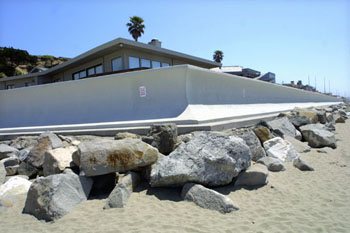![[MetroActive News&Issues]](/gifs/news468.gif)
[ Santa Cruz | MetroActive Central | Archives ]
Humpty Dumpty: Often federally funded, private seawalls degrade beaches that are already disappearing.
Beach Blanket
Beaches go down as seawalls go up
By Andrea Perkins
PIGGY BEACH isn't the only trouble spot in the county. Another one is the popular yet private stretch known as Hidden Beach in the Rio Del Mar area. The California Coastal Commission is getting a head start on a proscriptive rights study for the area, since Hidden Beach's owners (yes, it is owned) are trying to convince the county that it's the perfect place to put some more fancy houses, like the ones on Via Gaviota and Beach Drive that border Hidden Beach.
These types of homes and their accompanying seawalls present another problem that the Coastal Commission targets in its Public Access Action Plan: disappearing beaches. Experts have long agreed that California's sandy beaches are disappearing and that seawalls and protective boulders (called shoreline armoring) don't help. In addition to covering the sandy beach, armoring reduces the influx of sediment from coastal bluffs and scours beaches.
"It's a tragedy," says Linda Locklin, manager of the Coastal Commission's Coastal Public Access Program. A study done by the Coastal Commission in 1995 found that along the 83-mile-long Monterey Bay shoreline alone at least 12 miles, or 25 acres, of sandy beach have been covered by armoring. Projections show that if the trend continues at the current rate, 65 acres of Monterey Bay's sandy beach will be lost. The Live Oak beaches between Santa Cruz and Capitola are already almost totally armored.
For the past few years, one of the commission's "Priority Issue Areas" has been "eliminating public financial assistance to property owners who build or rebuild in known hazard zones." FEMA traditionally provides low-interest loans to coastal property owners for emergency armoring and rebuilding following heavy storms. The Coastal Commission's Public Access Action Plan states that "FEMA assistance to private property owners who have built in areas of high coastal hazards provides a direct public subsidy to private development. Statewide, shoreline protection and repair of damaged structures has averaged over $100 million annually."
Locklin points out that losing beaches also means losing important revenue. According to a 1997 report by the Public Research Institute of San Francisco called The Economic Value of California's Beaches, "coastal-related recreation spending ... represented almost 3 percent of the total economic activity in California in 1995." The report also found that "California spends less on preservation of its beaches than other states with long ocean coasts." For more info, go to the Coastal Commission's website: www.coastal.ca.gov.
[ Santa Cruz | MetroActive Central | Archives ]
Copyright © Metro Publishing Inc. Maintained by Boulevards New Media.
![]()

Photograph by George Sakkestad
From the May 23-20, 2001 issue of Metro Santa Cruz.